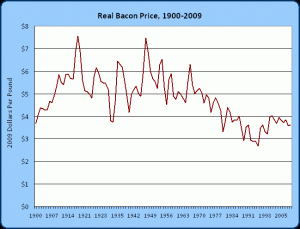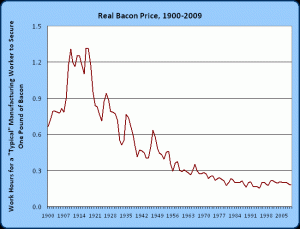Look at what has happened to the scarcity of bacon over the past 100 years.
The top chart adjusts nominal bacon prices to account for the general rise in prices since 1900 using a measure of the CPI’s broad inflation index. The bottom chart takes a different approach to adjust the bacon data. It looks at the hourly wage of a typical manufacturing worker and asks how many hours would a typical worker need to work in order to secure a unit of bacon.
(note, I imputed the hourly wages for 1915-1918). Bacon data from US Census, CPI data from BLS and wage data from Historical Statistics of the United States and BLS.
By any metric, the scarcity of bacon is no higher today (in fact, it is much lower) than it was over 100 years ago, even as human consumption of bacon has rocketed with economic growth and population growth. In real terms, bacon prices have fallen by 1% since 1900 from $3.67 per pound to $3.63 per pound today. In 1900, it took a typical manufacturing worker 40 minutes of work to secure himself a pound of bacon. Today, a similar worker would only have to work 11 minutes to get it – a decrease of over 73 percent over the course of the century. And as I will show you, these are lower bounds for just how much less scarce bacon really has become. Bacon prices would have to rise to $13.32 per pound to make it just as hard for a typical worker to get it today as it was in 1900. Alternately, if bacon prices remain unchanged, the typical worker would have his pay slashed to just over $5.44 per hour in order to be in a position that his 1900 counterpart was in.
But this is just bacon, right?


Glad I’m not in the hog business.
You must continue this after twelve days. Looking forward to the graphs on corn and milk, which, for the USDA should be revealed before Epiphany.
[…] His point is that these goods are growing ever more scarce, yet generally the cost (computed in both work hours and real price) is much lower. He argues that this is not merely incidental to each commodity, but true as a general rule. Even something as fundamental as sweet delicious mouth-watering hickory smoked bacon. […]